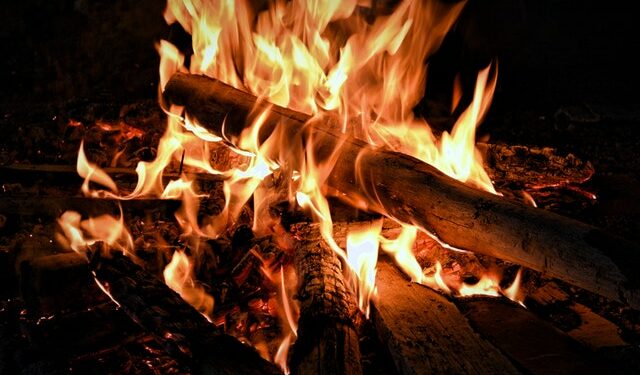How hot is fire from wood

There is no one definitive answer to this question. The amount of heat produced by a fire burning wood will depend on a variety of factors, including the type of wood being burned, the size and age of the tree, and the conditions under which the fire is burning. Generally speaking, however, fire from wood can be quite hot, and can easily reach temperatures in excess of 1000 degrees Fahrenheit.
What is fire and how is it created
When most people think of fire, they think of the big, bad wolf from Little Red Riding Hood. They see it as a destructive force, something to be feared and avoided. But fire is so much more than that. It’s an essential element of life, something that we need in order to cook our food and stay warm. Fire is also a great source of light, and can be used to signal for help in an emergency situation.
So how is fire created? It all starts with a little something called combustion. Combustion is a chemical reaction that happens when two substances come into contact with each other and create heat. This heat can then be used to ignite a fuel, like wood. Once the fuel is burning, the fire will continue to produce heat as long as there is a supply of oxygen.
What are the different types of wood?
There are many different types of wood, and each one burns differently. Some woods, like cedar, burn hot and fast, while others, like oak, burn slowly and evenly. The type of wood you use will have a big impact on the heat produced by your fire.
How big is the tree?
The size of the tree also plays a role in how hot your fire will be. A small tree will burn much more quickly than a large one, and will therefore produce less heat.
How old is the tree?
The age of the tree is another important factor. A young tree will have more sap, which makes it burn hotter than an older tree.
What are the conditions under which the fire is burning?
The conditions under which the fire is burning will also affect its heat output. If the fire is burning in a dry, oxygen-rich environment, it will be much hotter than if it is burning in a damp, oxygen-deficient environment.
In conclusion, there is no one definitive answer to the question of how hot is fire from wood. The heat produced by a fire burning wood will depend on a variety of factors, including the type of wood being burned, the size and age of the tree, and the conditions under which the fire is burning. Generally speaking, however, fire from wood can be quite hot, and can easily reach temperatures in excess of 1000 degrees Fahrenheit.
The different types of fire
There are many different types of fire, and each one burns differently. Some fires burn hot and fast, while others burn slowly and evenly. The type of fire you use will have a big impact on the heat produced by your fire.
In conclusion, there is no one definitive answer to the question of how hot is fire from wood. The heat produced by a fire burning wood will depend on a variety of factors, including the type of wood being burned, the size and age of the tree, and the conditions under which the fire is burning. Generally speaking, however, fire from wood can be quite hot, and can easily reach temperatures in excess of 1000 degrees Fahrenheit.
How wood creates fire
When most people think of fire, they think of the big, bad wolf from Little Red Riding Hood. They see it as a destructive force, something to be feared and avoided. But fire is so much more than that. It’s an essential element of life, something that we need in order to cook our food and stay warm. Fire is also a great source of light, and can be used to signal for help in an emergency situation.
So how is fire created? It all starts with a little something called combustion. Combustion is a chemical reaction that happens when two substances come into contact with each other and create heat. This heat can then be used to ignite a fuel, like wood. Once the fuel is burning, the fire will continue to produce heat as long as there is a supply of oxygen.
What are the different types of wood?
There are many different types of wood, and each one burns differently. Some woods, like cedar, burn hot and fast, while others, like oak, burn slowly and evenly. The type of wood you use will have a big impact on the heat produced by your fire.
How big is the tree?
The size of the tree also plays a role in how hot your fire will be. A small tree will burn much more quickly than a large one, and will therefore produce less heat.
How old is the tree?
The age of the tree is another important factor. A young tree will have more sap, which makes it burn hotter than an older tree.
What are the conditions under which the fire is burning?
The conditions under which the fire is burning will also affect its heat output. If the fire is burning in a dry, oxygen-rich environment, it will be much hotter than if it is burning in a damp, oxygen-deficient environment.
In conclusion, there is no one definitive answer to the question of how hot is fire from wood. The heat produced by a fire burning wood will depend on a variety of factors, including the type of wood being burned, the size and age of the tree, and the conditions under which the fire is burning. Generally speaking, however, fire from wood can be quite hot, and can easily reach temperatures in excess of 1000 degrees Fahrenheit.
The temperature of a wood-fired flame
There is no one definitive answer to the question of how hot is fire from wood. The heat produced by a fire burning wood will depend on a variety of factors, including the type of wood being burned, the size and age of the tree, and the conditions under which the fire is burning. Generally speaking, however, fire from wood can be quite hot, and can easily reach temperatures in excess of 1000 degrees Fahrenheit.
How hot is fire from wood? It all depends on the factors mentioned above. So if you’re planning on building a fire, be sure to take these things into consideration in order to ensure that your fire burns as hot as you want it to.
Safety precautions when working with fires
When most people think of fire, they think of the big, bad wolf from Little Red Riding Hood. They see it as a destructive force, something to be feared and avoided. But fire is so much more than that. It’s an essential element of life, something that we need in order to cook our food and stay warm. Fire is also a great source of light, and can be used to signal for help in an emergency situation.
Despite its many uses, fire is still a dangerous force that should be respected. If you’re planning on building a fire, there are some safety precautions that you should take in order to ensure that your fire burns safely and doesn’t get out of control.
1. Only build a fire in a designated fire pit or fireplace. This will help to contain the fire and prevent it from spreading.
2. Make sure that there is nothing flammable within a 10-foot radius of the fire. This includes leaves, branches, and debris.
3. Never leave a fire unattended. If you have to leave for any reason, make sure that someone else is there to watch it.
4. Be sure to extinguish the fire completely before leaving the area. This includes pouring water on the ashes and stirring them around until they’re cold to the touch.
5. Never build a fire in an enclosed space, such as a tent. This can be extremely dangerous and can lead to asphyxiation.
By following these simple safety precautions, you can help to ensure that your fire burns safely and doesn’t get out of control. Remember, fire is a great tool, but it should always be respected.
Wood as an energy source
People have been using wood as an energy source for centuries. Wood is a renewable resource, and it’s easy to find and harvest. It also produces less pollution than other forms of energy, such as coal or oil.
But despite its many advantages, wood is no longer the most popular form of energy in the United States. In fact, it’s only used to generate about 1 percent of the country’s electricity.
There are a number of reasons for this decline. One is that wood is less efficient than other forms of energy. It takes more wood to produce the same amount of energy as coal or oil.
Another reason is that wood-burning power plants are dirty and produce a lot of pollution. They’re also a major source of air pollution, which can cause respiratory problems and other health problems.
So if you’re looking for an energy source that’s clean and efficient, wood may not be the best option. There are other options out there that might be better suited to your needs.
Pros and cons of using wood as a fuel
Whether you’re looking to heat your home or generate electricity, wood is a great option. It’s a renewable resource, it’s easy to find and harvest, and it produces less pollution than other forms of energy. But despite its many advantages, wood is no longer the most popular form of energy in the United States. In fact, it’s only used to generate about 1 percent of the country’s electricity.
There are a number of reasons for this decline. One is that wood is less efficient than other forms of energy. It takes more wood to produce the same amount of energy as coal or oil.
Another reason is that wood-burning power plants are dirty and produce a lot of pollution. They’re also a major source of air pollution, which can cause respiratory problems and other health problems.
So if you’re looking for an energy source that’s clean and efficient, wood may not be the best option. There are other options out there that might be better suited to your needs.
Why is wood no longer the most popular form of energy in the United States?
There are a number of reasons for this decline. One is that wood is less efficient than other forms of energy. It takes more wood to produce the same amount of energy as coal or oil.
Another reason is that wood-burning power plants are dirty and produce a lot of pollution. They’re also a major source of air pollution, which can cause respiratory problems and other health problems.
So if you’re looking for an energy source that’s clean and efficient, wood may not be the best option. There are other options out there that might be better suited to your needs.
How to store wood properly
When most people think of wood as an energy source, they think of chopping down a tree and using it to heat their home or generate electricity. But there’s more to wood than just that. Wood can also be stored properly so that you have a ready supply when you need it. Here are some tips on how to store wood properly:
1. Season the wood. Seasoning is the process of allowing the wood to dry so that it doesn’t rot or mold. You can season wood by stacking it in a dry, well-ventilated area for six to 12 months.
2. Store the wood in a shed or other covered structure. This will protect the wood from the elements and keep it dry.
3. Cover the wood with a tarp or other waterproof material. This will further protect the wood from moisture and keep it from rotting or molding.
4. Stack the wood off the ground. Stacking the wood off the ground will allow air to circulate around it and keep it dry.
5. Keep the wood away from sources of heat. Heat can dry out the wood and make it more susceptible to cracking or splitting.
By following these tips, you can ensure that your wood is properly stored and will be ready to use when you need it.
How hot is fire from wood
Wood is a popular choice for an energy source because it’s renewable, easy to find and harvest, and produces less pollution than other forms of energy. But despite its many advantages, wood is no longer the most popular form of energy in the United States. There are a number of reasons for this decline, including that wood is less efficient than other forms of energy and that wood-burning power plants produce a lot of pollution.
When most people think of wood as an energy source, they think of chopping down a tree and using it to heat their home or generate electricity. But there’s more to wood than just that. Wood can also be stored properly so that you have a ready supply when you need it.






